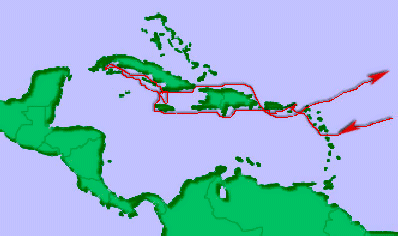News about maps
Digital cartography and GPS navigation
Mapstor news
This Day in History
Travelling with mapstor.com
This Day in History
4th December, 1674 Marquette founded the first European settlement
19th November, 1875 was born Hiram Bingham
18th November, 1832 was born Nils Adolf Erik Nordenskiöld
14th November, 1963 the island Surtsey was founded
11th November, 1729 was born Louis Antoine comte de Bougainville
25th September, 1493 started second expedition of Columbus
 On the 25th of September, 1493 ships sailed off from Cadiz under the command of the legendary explorer and discoverer Christopher Columbus. According to various sources, the second expedition consisted of 1,500 to 2,500 people - sailors, priests and monks, nobles and courtiers, officials, seduced by the possibility of a quick profit at the newly discovered lands. On board the ships there were donkeys and horses, cattle, pigs, seed crops and vines, which were required for the organization of the colony.
On the 25th of September, 1493 ships sailed off from Cadiz under the command of the legendary explorer and discoverer Christopher Columbus. According to various sources, the second expedition consisted of 1,500 to 2,500 people - sailors, priests and monks, nobles and courtiers, officials, seduced by the possibility of a quick profit at the newly discovered lands. On board the ships there were donkeys and horses, cattle, pigs, seed crops and vines, which were required for the organization of the colony.
In contrast to the first trip, this time Columbus set the course 10° degrees to the south, caught the tail wind and was able to cross the ocean in a record short time - 20 days. In November, the ships reached the island which Columbus named the Dominican Republic. The island was discovered on Sunday, and "Dominic" translates from Spanish as "Sunday." Then the expedition turned north. On the way Columbus discovered and noted on a map several islands, including St. Croix, St. Eustatius and St. Kitts, Saba, Montserrat, Nevis, Guadeloupe and Antigua. Continuing to set the course to the north, he saw the land, consisting of forty islands, which was called the Virgin Islands (in the lane. Spanish "Maiden").
In late November, the ships moored in Hispaniola (Haiti), where sailors saw a spooky scene. Fort, which was built here in the first voyage, was burned. None from Europeans was alive: some were killed by local people, others - drowned trying to escape by boat. The team built up a new fort and went in search of new lands. The expedition rounded Cape Mays, passed along the southeastern coast of Cuba, reached the island of Jamaica, where it turned back toward Cuba, came to Cape Cruz, went to the West and, reaching up to 84° W and turned back. Having covered the distance of 1700km, Columbus did not reach 100 km to the western tip of Cuba, and had to return due to the fact that the sea became shallow. The ships entered the harbor of Cadiz in June 1496.
The result of the second voyage of Columbus was the conquest of Hispaniola and killing of local residents, appearance of the city of Santo Domingo on the map, the best laid sea route to the West Indies and the map of the southern coast of Cuba. Among the discoveries - the island of Puerto Rico, Jamaica, the Lesser Antilles and the Virgin Islands. However, Columbus was sure that his ships swept in the West Indies. It is noteworthy that the sea route to India was discovered only in the XVI century. However, the islands, which appeared on the map thanks to Columbus, were given the name "West Indies."
Despite the fact that with the sailing of Columbus the Map of that time was greatly enriched, it was considered a failure. That's because gold was not discovered in desired quantities, and in organized colony Isabella there were epidemics. In Spain, Columbus was given cold shoulder and later he was deprived of many privileges.
This Day in History 25-09-2012


